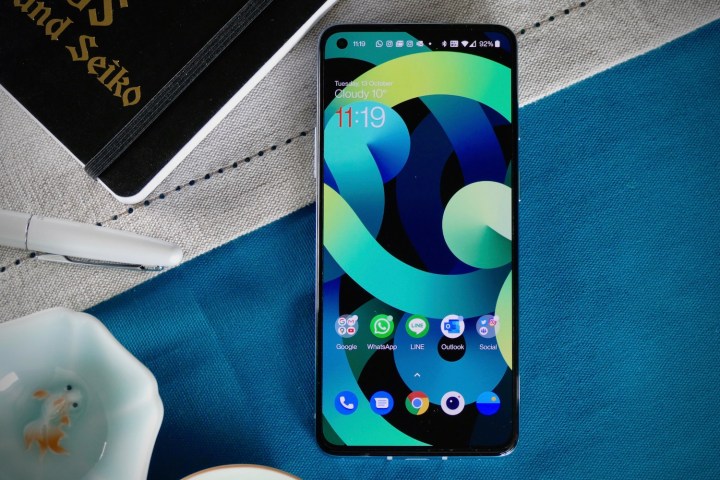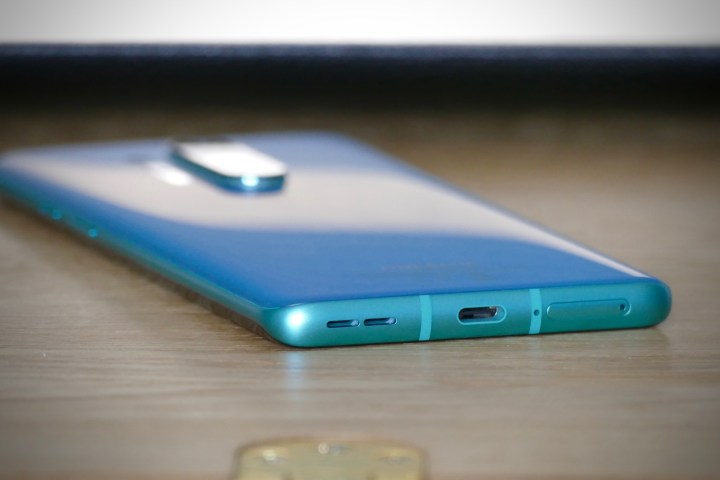The OnePlus 8 Pro was released barely six months ago; the OnePlus 8T just emerged to take its crown as the souped-up OnePlus flagship of choice. It boosts the OnePlus 8’s specs with a very fluid 120Hz refresh rate, a fun monochrome camera lens, a more contemporary redesign, and supremely fast charging. It’s arguably better than the standard OnePlus 8, but is it better than the OnePlus 8 Pro?
We seek to answer this question by comparing the two phones in a head-to-head. We take a closer look at the specs of the OnePlus 8T and 8 Pro, weighing up their displays, performance, cameras, batteries, and special features. This should help you decide which is the best premium OnePlus phone for you.
Specs
| OnePlus 8 Pro | OnePlus 8T | |
| Size | 165.3 x 74.4 x 8.8mm (6.51 x 2.93 x 0.35 inches) | 160.7 x 74.1 x 8.4 mm (6.33 x 2.92 x 0.33 inches) |
| Weight | 193 grams (6.81 ounces) | 188 grams (6.63 ounces) |
| Screen size | 6.78-inch Fluid AMOLED (120Hz) | 6.55-inch Fluid AMOLED (120Hz) |
| Screen resolution | 3168 x 1440 pixels (513 pixels-per-inch) | 2400 x 1080 pixels (402 pixels per inch) |
| Operating system | OxygenOS 11, Android 11 | OxygenOS 11, Android 11 |
| Storage | 128GB, 256GB | 128GB, 256GB |
| MicroSD card slot | No | No |
| Tap-to-pay services | Google Pay | Google Pay |
| Processor | Qualcomm Snapdragon 865 | Qualcomm Snapdragon 865 |
| RAM | 8GB, 12GB | 8GB, 12GB |
| Camera | Quad lens 48-megapixel wide-angle, 48MP ultra-wide, 8MP telephoto rear, and Color Filter rear, 16MP front | Quad lens 48MP wide, 16MP ultrawide, 5MP macro, and 2MP monochrome rear, 16MP front |
| Video | 4K at 60 frames per second, 1080p at 240 fps, 720p at 960 fps | 4K at 60 fps, 1080p at 240 fps |
| Bluetooth version | Bluetooth 5.1 | Bluetooth 5.1 |
| Ports | USB-C, 3.1 | USB-C, 3.1 |
| Fingerprint sensor | Yes, in-display | Yes, in-display |
| Water resistance | IP68 | No official rating |
| Battery | 4,510mAh
Warp Charge fast-charging (30W) Fast Qi wireless charging (30W) |
4,500mAh
Warp Charge fast-charging (65W) |
| App marketplace | Google Play Store | Google Play Store |
| Network support | Verizon, T-Mobile | T-Mobile |
| Colors | Glacial Green, Ultramarine Blue, Onyx Black | Aquamarine Green, Lunar Silver |
| Prices | $900+ | $749+ |
| Review score | 4 out of 5 stars | 3.5 out of 5 stars |
Design, display, and durability

The OnePlus 8T and 8 Pro unsurprisingly look very similar at first glance, with both phones featuring a sleek edge-to-edge display with an aluminum frame and glass back. The 8T updates this template by repositioning the 8 Pro’s camera module, which had previously been placed in the back’s center, in a single line. It now puts all four of its lenses in a rectangular module in the top-left, a change that arguably looks much tidier, even if it kind of rips off the layouts you’ll find on recent Samsung phones. The 8T is also a little less tall, a little thinner, and a little lighter, improving subtly on the comfort provided by the 8 Pro.
The OnePlus 8T also comes with a very nice 6.55-inch Fluid AMOLED screen, which offers a resolution of 2400 x 1080 pixels (402 pixels per inch). This is very attractive, but it’s still no match for the 8 Pro’s 6.78-inch display, which packs a whopping 3168 x 1440 pixels into its impressive frame, working out at 513 ppi. It certainly has a “wow” factor the 8T lacks, although both devices come with a 120Hz refresh rate, so you’ll hardly be disappointed by the 8T.
The OnePlus 8T also has another weakness in comparison to the 8 Pro: it lacks an official IP rating, just like the standard OnePlus 8. Fortunately, the OnePlus 8 Pro carries an IP68 rating, so anyone who likes bathing with their phone will be pleased by its sturdy durability.
Together with its stunning display, the durability of the OnePlus 8 Pro means that it takes this opening round quite comfortably.
Winner: OnePlus 8 Pro
Performance, battery life, and charging

As far as performance goes, the OnePlus 8T and 8 Pro are pretty much the same machine. They both deliver 8GB of RAM, or 12GB if you order one in the United States. They also use the Snapdragon 865 processor, which will certainly deliver the goods when combined with 8GB or 12GB of RAM. In other words, they’ll handle all of the latest games and apps, while smoothly juggling different tasks and functions.
Both phones also come with 128GB of internal memory as standard, or 256GB of memory (again) if you happen to be an American resident. They both lack a MicroSD card slot, but with 256GB of storage, even compulsive photographers should have enough space to see them through the duration of either phone’s lifespan.
However, while the two phones are basically identical in terms of RAM and ROM, the OnePlus 8T pulls ahead by virtue of its battery. At 4,500mAh, it’s actually 10mAh smaller than the OnePlus 8 Pro’s, but any inferiority in battery life is compensated for by the 8T’s ridiculously fast charging capabilities. It supports 65W Warp Charging, which is capable of getting you from 0% to 60% in 15 minutes, and from 0% to 100% in about 39 minutes. This makes the phone perfect for anyone with a particularly busy lifestyle, even though the 8T (unlike the 8 Pro) doesn’t support wireless charging.
This may be a relatively modest advantage, but with the two phones equal in all other performance respects, we’re declaring a narrow victory for the 8T.
Winner: OnePlus 8T
Cameras

It’s a similar story with the cameras of the two phones, with the 8T and 8 Pro having a comparable core setup that differs in at least one important respect. They both feature a quad-lens rear camera system, with the 8T housing a 48-megapixel wide lens, a 16MP ultrawide camera, a 5MP macro, and a 2MP monochrome lens. By contrast, the 8 Pro comes with a 48MP wide lens, a 48MP ultrawide, an 8MP telephoto, and a 2MP color filter.
Taking the wide and ultrawide lenses in isolation, the 8 Pro arguably takes slightly better pictures overall than the 8T. It offers excellent dynamic range, well-balanced color saturation, as well as a highly capable night mode. However, even if it is a touch more capable than the 8T, it slips up with the inclusion of its color filter. This is a lens that inverts the colors of your pictures, giving them a kind of washed-out sepia look. As we wrote in our review, it’s mystifying as to why OnePlus chose to include this, since you’ll likely use it once and forget about it.
On the other hand, it certainly isn’t mystifying as to why OnePlus went with a monochrome lens for the 8T. This lets you take black-and-white photos without having to use a software filter, and while it also falls into the “novelty” category, it has much more utility and longevity than the 8 Pro’s color filter.
Both the OnePlus 8 Pro and 8T are capable of capturing 4K video at 60 frames per second, as well as 1080p video at 240 fps. This puts them on a level pegging, and with the 8 Pro’s slightly better camera canceled out by the useless color filter, we’re calling this round a tie.
Winner: Tie
Software and updates

Yes, the OnePlus 8T and 8 Pro both use OnePlus’ very own Android 11 skin, OxygenOS 11. It’s one of the most streamlined and attractive versions of Android around, with the latest version adding an always-on display and improving on the game mode and Digital Wellbeing feature.
Both phones will also have a similar experience with updates. Fortunately, OnePlus is one of the best manufacturers for rolling out Android updates in a fairly timely manner. It has also committed to providing security updates for each phone for three years, so you’ll get pretty good use out of both of them.
This round is, unsurprisingly, a tie.
Winner: Tie
Special features

The OnePlus 8T and 8 Pro support 5G, but both phones are compatible only with the slower sub-6Hz bands, leaving out support for the faster mmWave frequencies. That said, sub-6Hz 5G is still much faster than 4G, while it’s also longer range than mmWave, so anyone with 5G in their area will remain pretty pleased with either phone.
5G support is the main special feature on offer with both phones, but they also include several OnePlus-only software features. There’s the aforementioned gaming mode, which turns off notifications while improving on app and network speed. There’s also Zen Mode, which is a do-not-disturb mode that severely limits what you can do with your phone, so as to save you from distraction and disturbance.
One special feature the OnePlus 8T has that the 8 Pro doesn’t is its 65W Warp Charging. This may not be a major feature, but it can really be a timesaver, particularly for those who travel often and don’t have many opportunities to recharge.
However, because the 8T doesn’t support wireless charging (while the 8 Pro does), we’re calling another tie.
Winner: Tie
Price and availability
The OnePlus 8T is available now and can be ordered from OnePlus, with prices starting at $749. It’s supported only by T-Mobile in the United States, while you can find it from such major retailers as Amazon.
The OnePlus 8 Pro costs $1,000 for the 12GB RAM/256GB storage version, or $900 for the 8GB/128GB model. It’s available from Verizon in addition to T-Mobile, and also be found with select retailers.
Overall winner: OnePlus 8 Pro
This is one of the tightest head-to-heads we’ve had to judge, but the OnePlus 8 Pro just about beats the OnePlus 8T overall. Its screen is absolutely breathtaking, while its main camera lenses provide a little bit more quality than the 8T’s. Its battery life is also excellent, while its performance is equal to the newer phone’s, as is its software.
Having said that, the 8T really isn’t that far behind. Its design is very attractive, it adds a monochrome lens that’s more useful than the 8 Pro’s color filter, and it also provides super-fast charging. There’s also the important fact that it’s either $150 or $250 cheaper than the 8 Pro, although it provides many of the same features and capabilities. If you want to save some money while buying a new Android, you’d therefore struggle to be disappointed with it.



